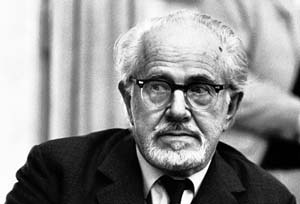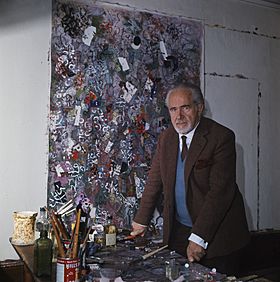Mark Tobey facts for kids
Quick facts for kids
Mark Tobey
|
|
|---|---|

Tobey in 1964
|
|
| Born | December 11, 1890 Centerville, Wisconsin, U.S.
|
| Died | April 24, 1976 (aged 85) |
| Education | School of the Art Institute of Chicago |
| Known for | Painting |
| Movement | Abstract Expressionism Northwest School |
| Patron(s) | Zoe Dusanne |
Mark George Tobey (born December 11, 1890 – died April 24, 1976) was an American painter. He was known for his unique paintings that looked like abstract art. His art was inspired by Asian calligraphy, which is a beautiful way of writing.
Tobey's work was famous in both the United States and Europe. He was also one of the founders of the Northwest School. This was a group of artists from the Pacific Northwest. Tobey was older and more experienced than the others. He shared his interest in philosophy and Eastern religions with them.
Like many artists in the Northwest School, Tobey mostly taught himself art. He had some early training at the Art Institute of Chicago. In 1921, he started the art department at The Cornish School in Seattle, Washington.
Mark Tobey loved to travel. He visited many places like Mexico, Europe, China, and Japan. He became a follower of the Baháʼí Faith, which became very important in his life. Tobey's paintings often covered the whole canvas. They used brushstrokes that looked like Asian writing. Some people wonder if his style influenced Jackson Pollock's famous "drip paintings."
Tobey was born in Centerville, Wisconsin. He lived in the Seattle, Washington area for most of his life. In the early 1960s, he moved to Basel, Switzerland, with his friend Pehr Hallsten. Tobey passed away there in 1976.
Contents
Early Life and Art Studies
Mark Tobey was the youngest of four children. His father, George Tobey, was a carpenter. He sometimes carved animals from stone. He also drew animals for young Mark to cut out. In 1893, his family moved to Chicago.
Tobey studied at the Art Institute of Chicago from 1906 to 1908. But he mostly learned art on his own. In 1911, he moved to New York City. There, he worked as a fashion illustrator for a magazine called McCall's.
His first art show was in 1917 at Knoedler & Company in New York. The next year, Tobey met Juliet Thompson. She was a portrait artist in New York and a follower of the Baháʼí Faith. Tobey learned about the Baháʼí Faith from her. He decided to join the faith. This made him want to show spiritual ideas in his art. In the years that followed, Tobey explored Arabic literature and Eastern philosophy.
Art Career and Travels
Starting in Seattle
Tobey moved to Seattle in 1921 for a fresh start. In 1922, he met Teng Kuei. Teng Kuei was a Chinese painter and a student at the University of Washington. He taught Tobey about Eastern writing styles. This started Tobey's interest in Chinese calligraphy.
Tobey began his many travels in 1925. He went to Europe and lived in Paris for a while. There, he met the famous writer Gertrude Stein. He also visited Barcelona and Greece. In places like Constantinople, Beirut, and Haifa, he studied Arab and Persian writing.
When Tobey returned to Seattle in 1927, he shared a studio with a younger artist named Robert Bruce Inverarity. Inverarity's school project inspired Tobey to try making three-dimensional art. Tobey carved about 100 pieces of soap sculpture. In 1928, Tobey helped start the Free and Creative Art School in Seattle. He also taught an art course at Emily Carr's studio in Victoria.
Growing Recognition
In 1929, Tobey had a solo art show in New York. Alfred H. Barr, Jr., a curator from the Museum of Modern Art (MoMA), saw his work. He chose some of Tobey's paintings for a MoMA exhibition in 1930.
In 1931, Tobey became an artist-in-residence at the Elmhurst Progressive School in England. He also taught at Dartington Hall in Devon. He became good friends with Bernard Leach, a famous potter. Tobey introduced Leach to the Baháʼí Faith, and Leach became a follower. During his time in England, Tobey traveled to Mexico (1931) and Palestine (1932).
In 1934, Tobey and Leach traveled together through France and Italy. Then they sailed to Hong Kong and Shanghai. Tobey visited his old friend Teng Kuei in Shanghai. He then went to Japan. In Japan, he studied Zen poetry and calligraphy at a monastery near Kyoto. He returned to Seattle in the autumn.
Tobey had his first solo exhibition at the Seattle Art Museum in 1935. He also traveled to New York, Washington, D.C., and Haifa for a Baháʼí pilgrimage. Around this time, he painted a series of three paintings. These paintings, like Broadway, used a style that became known as "white writing." This style used fine white lines that crisscrossed each other.
Later Career and Fame
Tobey planned to teach in England again in 1938. But tensions in Europe kept him in the US. Instead, he worked on the Federal Art Project. In 1939, Tobey met Pehr Hallsten. They became companions and lived together from 1940.
By 1942, Tobey was exploring new ways of abstract art. Marian Willard of the Willard Gallery in New York saw his paintings. She gave him a successful show in 1944. In 1945, he had a solo exhibition at the Portland Art Museum. The Arts Club of Chicago also showed his work in 1940 and 1946.
Tobey studied piano and music theory. He became friends with musicians like Lockrem Johnson and Wesley C. Wehr. Tobey's art was shown at New York's Whitney Museum in 1951. He also taught at Yale University for three months. His first big show looking back at his career was in San Francisco. In 1952, a film about Tobey called "Tobey, Mark: Artist" was shown at film festivals.
In 1953, Life magazine published an article about Tobey and three other artists. They were called the "Mystic Painters of the Northwest." This made them famous across the country. These four artists are considered the founders of the Northwest School.
In 1958, Tobey won the International Grand Prize at the Venice Biennale. He was the second American artist ever to win this award.
Final Years
Tobey and Pehr Hallsten moved to Basel, Switzerland, in the early 1960s. Tobey focused on his art there. In 1961, he became the first American painter to have an exhibition at the Pavillon de Marsan in Paris.
Major art shows of his work happened at MoMA in 1962 and the Stedelijk Museum in 1966. He visited the Baháʼí World Center in Haifa in 1966. In 1974, a large exhibition of his art was held at the Smithsonian's National Collection of Fine Arts. Mark Tobey passed away in Basel in 1976.
In 2017, a major exhibition of Tobey's art was held in Venice, Italy. This show helped people around the world appreciate his art even more.
Art Style

Tobey is most famous for his "white writing" style. In these paintings, he used white or light-colored brush strokes that looked like writing. He painted these over an abstract background of soft colors. This method led to a style called "all-over" painting. This style became very famous with artists like Jackson Pollock.
When Tobey first showed his white writing art, he wanted people to understand it. His art was different because it came from Seattle and had strong ties to Asian art. An art expert named Sidney Janis wrote about Tobey's work. He explained that Tobey's style was careful and controlled. It was different from the "automatic writing" used by some other abstract artists.
For example, Tobey's painting Threading Light (1942) has been compared to Pollock's Night Mist (1945).
Influence on Other Artists
Tobey was an important influence on other artists. He was the oldest of the "mystical painters." He also studied piano and music theory with John Cage, a famous composer. Tobey later influenced Cage's work.
In 1944, artist Elizabeth Bayley Willis showed Tobey's painting Bars and Flails to Jackson Pollock. Pollock studied the painting closely. He then painted Blue Poles. This painting became very famous.
A writer who studied Pollock said that Tobey's "dense web of white strokes, as elegant as Oriental calligraphy, impressed Jackson so much." Pollock went to all of Tobey's art shows. Tobey's paintings were usually small to medium-sized. Pollock then took Tobey's idea of covering the whole canvas with marks. He made much larger paintings by pouring paint onto the canvas. Pollock was very interested in Tobey's idea of covering the entire canvas, even its edges. This was something new in American art.
Legacy
Many of Mark Tobey's artworks are in museums today. You can find his paintings in the Museum of Northwest Art. His work is also in major museums in the U.S. and around the world. These include the Smithsonian American Art Museum, the Tate Gallery in London, and the Museum of Modern Art in New York City.
There have been many art shows celebrating Tobey's work since he passed away. These include exhibitions in Washington, D.C., Germany, Switzerland, and Spain. Two of his paintings are in the Guggenheim collections. Some of his art is also held by the Dartington Hall Trust.
Four of Tobey's signed prints hang in the Seat of the Universal House of Justice. This is the main building for the Baháʼí Faith. His art was inspired by Asian influences and his Baháʼí beliefs.
A type of sea snail called Anatoma tobeyoides is named after Mark Tobey.
Awards
- 1968: "Commander, Arts and the Letters of the French Government"
- 1961: Won first prize at the Carnegie International in Pittsburgh
- 1959: Became the first American since James McNeill Whistler to win the Painting Prize at the Venice Biennale
- 1956: Elected to the National Institute of Arts and Letters
- 1956: Received the Guggenheim International Award
See also
 In Spanish: Mark Tobey para niños
In Spanish: Mark Tobey para niños



